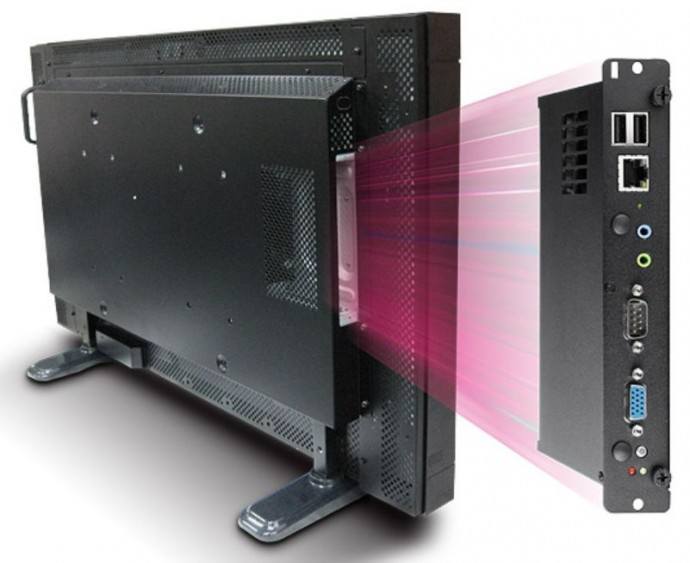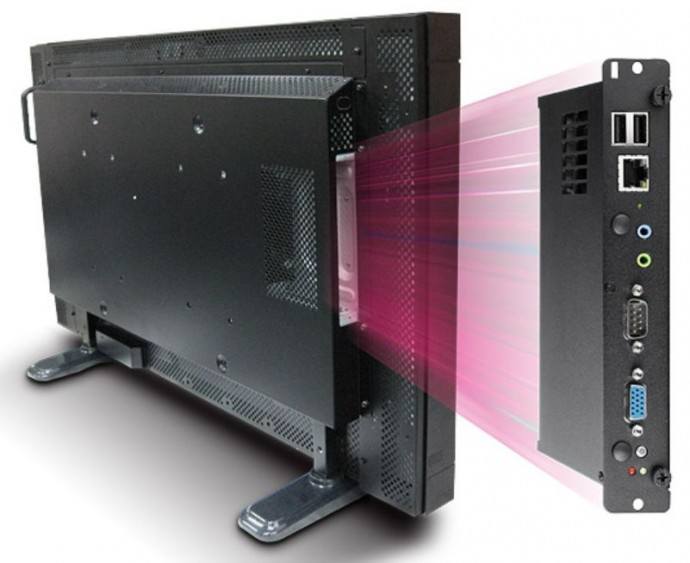
Guest Post: Is Open Pluggable Still Relevant For Digital Signage?
July 29, 2014 by guest author, Tara Parachuk

Guest Post: Manuel Edghill, Digbil
Is it time to yank OPS from the digital signage lexicon?
Launched in 2010, a hardware standard named Open Pluggable Specification (OPS) was released, aiming to reduce digital signage market fragmentation and simplify device installation and maintenance. It has largely failed to achieve these objectives, due to high implementation costs, and lack of widespread industry adoption.
OPS was a good idea when it launched, but times have changed. Displays of yesteryear were thick and required metal chassis to deal with high thermal levels. OPS was seen as a compact, cost-effective solution to fit into such environments. However, the last four years have seen dramatic advances in display and computing technology. OPS is now an expensive, over-engineered solution that is ill-fit for many applications.
Hardware specifications like OPS risk stifling innovation by locking people into a pre-defined blueprint that fails to account for future advancements in technology.
If your digital signage application involves more than one display, you should consider these questions before choosing OPS as the brains behind your hardware.
1. Is minimizing the cost per channel in your digital signage use case important?
In an OPS architecture, every display requires its own OPS module. What this means is that every display requires a processor and all the internal components that comprise a mini PC. On top of that, being small in size brings additional costs stemming from the miniaturization of its technology. In synthesis, what is great news for vendors selling OPS is not so good for your budget.
In a retail application with five signs, you could easily spend in excess of $4,000 USD on OPS modules alone.
2. Would you like to have synchronized multi-screen content, or content which spans across multiple screens?
The most impressive digital signage applications are those that make you stop in your tracks with extraordinary content. A great way this can be achieved is when content spans across multiple screens, and even interacts with the screen’s layout.
How can this be accomplished in an OPS architecture? It can’t. At least not in an easy, reliable, synchronized manner. Instead, each display is treated as an independent entity for content scheduling and playback purposes, making it extremely difficult for your average signage user to accomplish.
3. Is serviceability and ease of replacement important when something goes wrong?
OPS modules are typically found inserted in the bottom or side of the displays. One large problem with this is accessibility when maintenance is required. If your application has screens in an inaccessible location, such as high off the floor like in menu boards, how will you service the unit without having to climb up a ladder, or even worse, interrupting your sales process?
We have seen multiple installations with screens installed next to each other, effectively blocking access to the OPS module once installed. What happens if the OPS module fails? Not only could replacing it be tricky from an accessibility standpoint, but also quite a costly proposition when you account for the time spent by the maintenance guy climbing up and servicing the modules.
Even if your use case only calls for a single screen, with simple video playback and no need for advanced features like demographics analysis, OPS is still ill-suited for the task.
A much better option would be one of the myriad of cheap players that support such uses.



A few quick counterpoints: I think OPS has a role to play in the market, especially for screens that are within reach of consumers such as in stadiums, public transit, and malls. Ease of cabling and replacement is a significant factor in determining the ROI of the units and OPS players have a leg up over traditional units in this regard.
It’s worth noting that some OPS units now have a secondary video output so that one OPS player can drive two screens. This reduces costs and simplifies servicing when screens are mounted back to back.
Finally, there are multiple ways in which content can be synchronized across screens. Our EnGage technology supports zone synchronization on up to 6 video outputs from one media player as well as inter-player synchronization in which all screens within a subnet can synchronize. This is a software capability and works independently of the media player’s form factor.
Interesting article Manuel. Like all media player technology for digital signage, OPS has a place.
At Signagelive we are totally agnostic and our platform will work on any media device that has an IP address and can play media. With close on 20 years experience in this industry, we have seen the move from high-end PCs for digital signage to System on Chip displays requiring no external device. The one thing you cannot dismiss is the loyalty and technical or commercial reasons that resellers and end users choose a certain player technology over any other, even if the price is in some cases 10x more.
I agree that OPS launched with grand plans to standardise and simplify the all-in-one digital signage and despite uptake from NEC and Philips (plus a few others), the inability to onboard the major Korean display brands limited global mass-adoption. In addition, the initial pricing for OPS media players was significantly higher than a good quality PC, but with the recent release of the Anders OPS player based on the Raspberry Pi the affordability of an OPS offering is now comparable if not cheaper than a good quality robust PC.
With regards your specific points; the ability to incorporate the intelligence and flexibility of scheduling content to an individual display with an OPS is seen as a major benefit to many and by the time you incorporate video baluns connected to a centralised player along with the point-to-point cabling required, the cost increase is marginal. In addition, with each display having their own player you have no single point of failure, whereas, a single player goes-down when connected to to multiple displays and you loose them all.
We have just completed a major UK installation where we have 12 x 55″ screens with 12 x players running synchronised content delivering a total 1080 x 23,040 resolution image. This is easily achievable within our software (and other platforms) by marketing and creative people and is not difficult or reliant on a degree in IT. This did not use OPS, but it could have done and would have worked equally as well as the external PC solution specified by our reseller does. The alternative is a multi-ouput server connect to the 12 displays, which could be achieved but would not be much cheaper and again, would create a single point of failure for all 12 displays, which is far from ideal.
I accept your point about access to the OPS unit for maintenance in certain installations, and this is one of the key reasons that the reseller for the above 12 screen videowall installation decided to install the players in a dedicated rack and use video baluns to each of the screens.
With the Anders Pi OPS device now on the market and NEC pushing their Android OPS device at a very aggressive price, I expect we will see an increase and not decrease in our resellers and partners choosing OPS players for their digital signage projects.